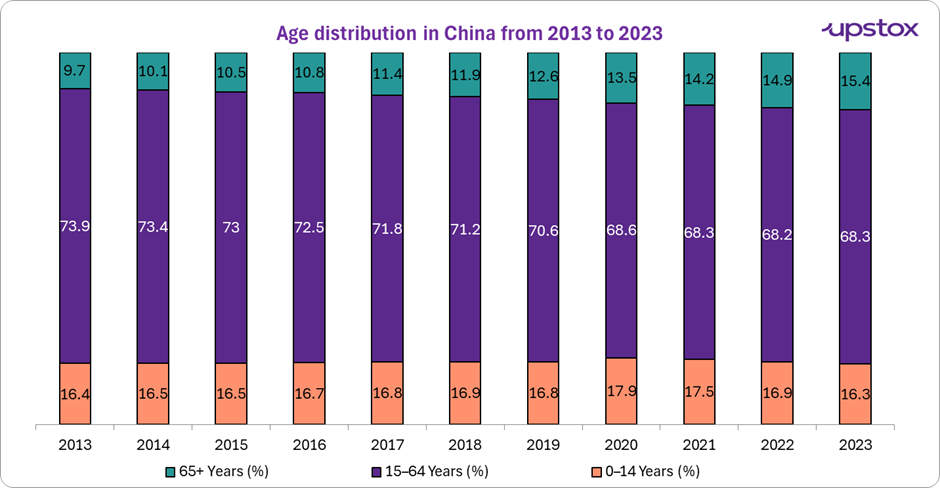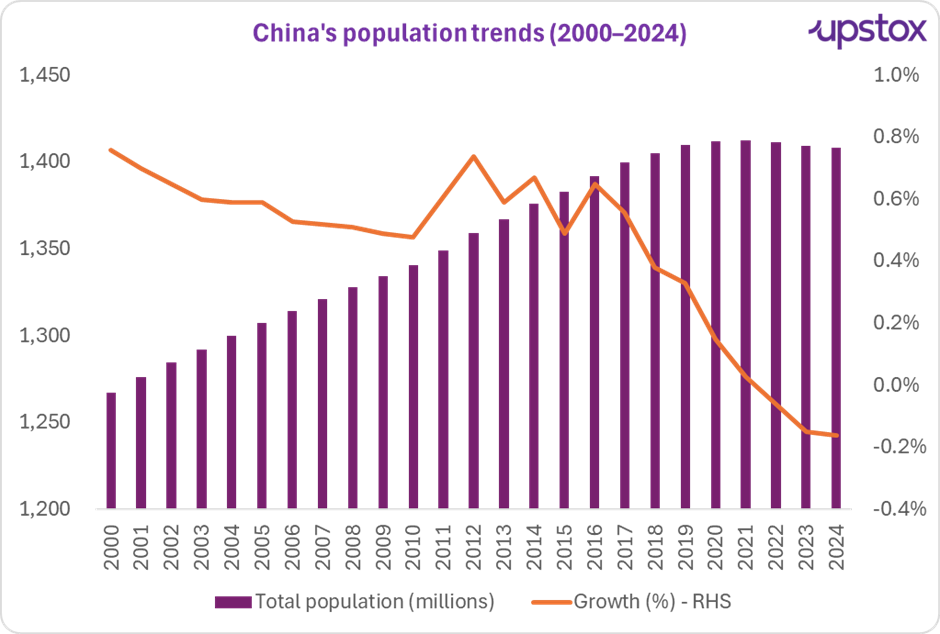Upstox Originals
From growth to grey in China's demographic shift
.png)
5 min read | Updated on January 24, 2025, 09:14 IST
SUMMARY
For the third year running, China's population has continued its steady decline. The National Bureau of Statistics revealed a drop of 1.39 million, bringing the count to 1.408 billion in 2024, down from 1.409 billion in 2023. This subtle yet significant demographic shift, driven by an ageing populace and persistently low birth rates, is quietly rewriting the narrative of the nation’s future.

For the third year running, China's population has continued its steady decline
Tides of global demographics paint a striking picture. India now leads as the world’s most populous nation, with over 1.44 billion people, while China, once unrivaled, faces a historic decline.

Source: UN World Population Dashboard and Bloomberg
China is rapidly becoming a "super-aged" society. By 2050, it is estimated that one-third, or 33%, of the population will be elderly, up from the current 15%.
| Country | Population (in millions) |
|---|---|
| India | 1,441.7 |
| China | 1,425.2 |
| United States | 341.8 |
| Indonesia | 279.8 |
| Pakistan | 245.2 |
Source: National Bureau of Statistics of China
This visualisation not only highlights the numbers but also underscores a story of contrasts. Over 14,000 kindergarten closures in China since 2017 signify the human cost of declining birth rates—a stark reminder of a nation grappling with its demographic crossroads.
A dwindling dragon: What’s causing China’s population crisis? What happens when the engine of the world’s factory begins to slow? China, long recognized for its economic strength, is now facing an unprecedented reality shaped by a declining population: a dwindling workforce, smaller families, and an increasingly ageing society.
Behind the headlines lies a complex web of cultural shifts, economic challenges, and the lasting legacy of strict policies. This population shift did not happen overnight; it is the result of interconnected factors that have been decades in the making.

Source: National Bureau of Statistics of China
Falling birth rates
Despite a slight rise in 2023, China’s fertility rate remains at 1.2 children per woman—far below the replacement level of 2.1. Efforts like financial incentives, such as Xpeng Motors’ $4,091 reward for a third child, haven’t reversed the trend.
Urbanisation and costs
According to a recent report by the China-based YuWa Population Research Institute, the cost of raising a child to the age of 18 in China is 6.3 times the country’s GDP per capita. This places China second only to South Korea in terms of the financial burden relative to income levels among East Asian countries.
Career-first mindset
A growing number of younger people, especially women, are delaying or opting out of marriage and parenthood altogether.
Gender imbalance
The one-child policy left China with a gender imbalance of 110 males for every 100 females, rising to 115.3 among teens, worsening birth rate and ageing population issues.
China’s battle plan to reverse the population slide
Facing a shrinking population, China is implementing diverse strategies, from policy changes to cultural campaigns, to secure a sustainable demographic future.
Policy overhaul for a new beginning
After decades of strict controls, China ended the one-child policy in 2015 and introduced the three-child policy in 2021, marking a shift to boost birth rates and reverse past restrictions.
China’s push for a birth-friendly society
China’s 13-point directive, issued by the State Council, addresses declining birth rates through expanded fertility services, improved childcare systems, and support in education, housing, and employment. It aims to create a family-friendly culture and reshape societal views on marriage and parenthood.
Cultural campaigns
China’s recently launched "love education" initiative in schools and universities promotes marriage and parenting, fostering positive attitudes and a supportive cultural environment to address declining birth rates.
Survey to understand childbearing attitudes
China is surveying 30,000 people across 150 counties and 1,500 communities, led by the Population and Development Research Center, to explore attitudes, fears, and hurdles shaping childbearing choices.
Workplace reforms
Extended parental leave, flexible work options, and workplace support aim to help parents balance careers and family life.
Ripple effects of a shrinking China
- Economic struggles at home
- Labour shortages: China’s working-age population is declining rapidly, projected to drag GDP growth by 1% annually over the next decade, according to UN data cited by Darren Tay of BMI.
- Pension system stress: With an ageing population, the ratio of workers to retirees is decreasing, placing immense pressure on China's pension system. The growing number of elderly citizens necessitates substantial financial resources for social security and healthcare services.
- Global ripple effects
- Supply chain shifts: Rising labour costs in China are driving manufacturers like Samsung, once holding 19% of the smartphone market in Q4 2013, to relocate production, with over 50% of its devices now made in Vietnam.
- Commodity fluctuations: Reduced demand from China may lower global raw material prices, reshaping markets. China is the largest consumer of most important global commodities. A decreasing population will gradually start impacting demand and lead to price volatility.
In summary
China’s demographic shift is rewriting its economic story, with automation, elder care, and healthcare emerging as the new protagonists. As the nation grapples with fewer hands and more silver hair, investors have a unique opportunity to back industries driving this transformation. The future belongs to those who can innovate within these challenges.
By signing up you agree to Upstox’s Terms & Conditions
About The Author
Next Story
